The book begins like a fictional tale, introduced by the photograph of a woman on a television screen, her hands on her face in a gesture of surprise, as if she had literally lost her head. It could be a story from another time, with its pale pink cover matching the barely visible wall in the photo of the actress on a television screen.
In the first third of the book J’ai perdu ma tête (“I Lost My Head”), Peter Granser refuses to show us who lives in the place where the story is set. The first images are of photographs hanging os bare walls, spray-painted drawings and sculptures of deformed faces reminiscent of art brut. Their heads are missing. Had they been slammed into a wall so hard that they fell off? It’s a mystery. A loose sheet of paper, folded in three, promises an answer. First, we see a man scratching the top of his head, confused. A nearby woman seems to be looking for something. A needle in a haystack? Her head, lost at the foot of the tree of knowledge? Unfolding the image, we discover a group of men whose faces are revealed in the following pages, inviting us to take a closer look, to decipher their traits, the expression in their eyes, the wrinkles of their age. Disfigured clay faces are mixed into the series of portraits, which are like headshots one might have seen at a casting session back when the movies were still looking for “mugs.” Another pieces of paper shows, in the same setting as the first, the same group of men They’re moving, and their theatrical body language calls to mind Denis Darzacq’s staged photographs of the disabled.
If it’s a fictional tale, it’s a social one. The final section of the book is a series of shots of neons, evoking windows opening onto the sky, imagination and freedom. The fiction disappears. We think back to the still life from the beginning of the work, with an empty cup and a syrupy, red line of medicine inside. Like the bare, neutral walls, these lights are typical of hospitals. Printed on ruled pink paper, the testimony of one of the residents confirms it. “I lost my head,” he repeats over and over in an attempt to retrace his own history with his faltering memory. And these walls, these neon lights and fields, are all in a psychiatric hospital in Evreux, France. “Peter Granser opens countless windows onto a unknown world of insanity,” Andrea Filippin insightfully wrote about this series. “And he does so by replacing the words with photography.” The editorial work of this young publishing house has displayed the same subtlety.
















